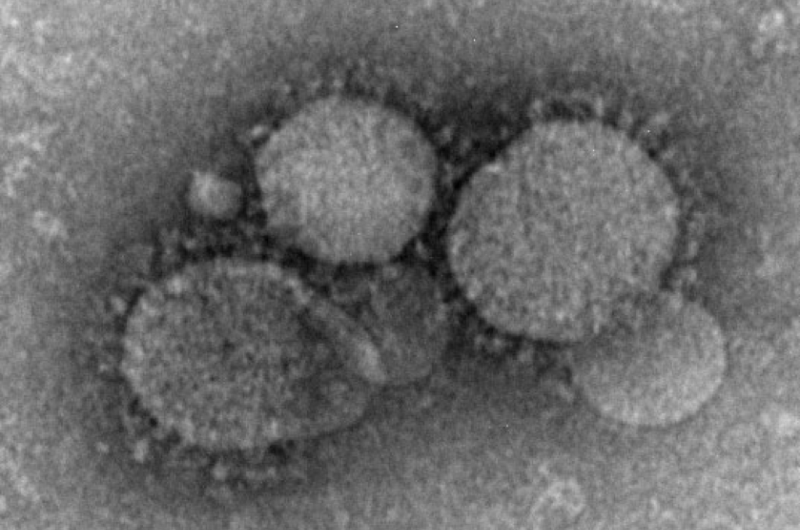3 coronavirus species co-circulating in dromedary camels in SA and Korean outbreak of MERS caused by recombinant variant

An international research team, led by Professor Yi Guan and Dr Huachen Zhu of the State Key Laboratory of Emerging Infectious Diseases and School of Public Health, Li Ka Shing Faculty of Medicine, The University of Hong Kong (HKU), in collaboration with King Abdulaziz University, Saudi Arabia; and scientists from Mainland China, Australia and Egypt revealed that the Middle East Respiratory Syndrome (MERS) coronavirus has become enzootic in dromedary camels in Saudi Arabia and diverged into five distinct lineages. Viruses that led to the Korean outbreak and the recent human infections in the Middle East were from lineage 5 and generated by recombination between viruses of lineages 3 and 4.
The researchers also found two other coronaviruses co-circulating with the MERS coronavirus in the camels, including one closely related to the human 229E coronavirus that causes common colds in humans. Co-infections of these different coronavirus species were frequently detected in camels, with over half of the MERS coronavirus-positive camels also carrying at least one of the other coronaviruses.
This work will be published online today (December 17) in the journal Science.
About MERS infections in humans
To date, over 1,300 laboratory-confirmed cases of human infection with the MERS coronavirus have been reported in 26 countries since 2012, with more than 500 deaths recorded by the World Health Organisation (WHO) and a fatality rate of 38%. Saudi Arabia is the country most affected, with over 75% of cases, followed by South Korea. To understand more about the source of this disease in animals, and how it might develop to threaten public health, researchers from HKU and other institutions jointly investigated the prevalence and evolution of coronaviruses in camels from Saudi Arabia.
Key research findings
The research team conducted surveillance in Jeddah, Taif and Riyadh from 2014 to 2015 and found coronaviruses were highly prevalent in dromedary camels from western and central Saudi Arabia. These viruses were predominantly shed from the respiratory tracts of camels, with over 25% of nasal swabs positive for coronaviruses, and only 1% of samples from digestive tracts positive. Thus, air-borne transmission is the most likely way to spread the virus.
By testing samples collected at wholesale markets, slaughterhouses and farms, the researchers found that the majority of the coronavirus-positive camels came from wholesale markets, where indigenous camels mixed with camels imported from Africa. Local camels had significantly higher positive rates for coronaviruses than imported camels. Young camels, under one year old, had the highest levels of respiratory infections, at 34%, with MERS or the other coronaviruses; approximately twice the rate seen in camels of other age groups.
Notably, the overall positive rate from the nasal swabs of the camels for the MERS coronavirus was 12%, with a peak during the winter season, December 2014 to January 2015, at 21-23%. Therefore, the MERS virus has become enzootic in dromedary camels in Saudi Arabia. Most affected camels show no overt signs of infection. This has made the recognition of infected camels and tracing the source of the virus difficult.
By utilising Next Generation Sequencing, the researchers obtained 93 full genomic sequences of camel coronaviruses, including 67 MERS coronaviruses. Systematic evolutionary studies found the MERS coronavirus has diverged into five distinct lineages. Viruses from lineage 5 were generated by recombination between those of lineages 3 and 4, and led to the recent outbreaks in Korea and the Middle East. This novel recombinant virus lineage appeared in Saudi Arabian camels as early as in July 2014, while human infections with viruses of this lineage were only reported from February 2015 onwards. The human MERS coronavirus identified in South Korea early this summer shows extremely high similarity to a camel virus sampled in March 2015 in Riyadh, indicating the origin of Korean viruses is from camels of the Middle East.
In addition to the MERS coronaviruses, the researchers also found two other coronavirus species co-circulating in Saudi Arabian camels, with one closely related to the human 229E coronavirus and the other similar to the HKU23 coronavirus previously reported in camels from Dubai. The 229E-like virus was found in the respiratory tract of 20% of Saudi Arabian dromedaries. In humans, coronavirus 229E is one of the most frequently detected causal agents of the common cold. Around 6.9% of Saudi Arabian camels were simultaneously infected by two or three coronavirus species, and over half of the MERS coronavirus-positive camels were also infected with at least one other coronavirus. Co-infections of different coronavirus species occur frequently in camels, highlighting the role of dromedary camels as an important host for coronaviruses.
Research implications and suggestions
Dromedary camels are the direct source of human infections with the MERS coronavirus, and they also serve as natural hosts for the two other coronavirus species found in this study (the 229E-like and the HKU23-like camel viruses). The MERS coronavirus has become enzootic in Saudi Arabia. Young dromedary camels play an important role in maintaining and spreading this virus. Winter is the peak season for coronavirus infections in camels, and the site of virus replication and shedding is the nasal cavity.
The researchers suggest that policies to prevent direct contact with camels, especially their oral and nasal tracts, to maintain good personal hygiene and to avoid exposure to contaminated materials or environments should be reinforced. Together with effective surveillance and control measures, this will break the transmission chain of the virus and reduce the threat to public health.
More information: "Co-circulation of three camel coronavirus species and recombination of MERS-CoVs in Saudi Arabia," DOI: 10.1126/science.aac8608
















